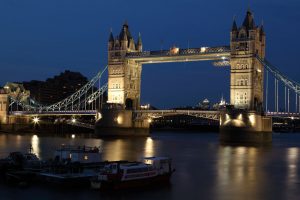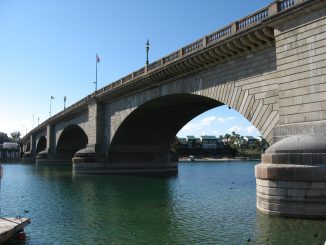
One of the most iconic attractions in London is the Tower Bridge. A combined bascule and suspension bridge that crosses the River Thames close to the Tower of London, the Tower Bridge connects the Southwark bank and the northern landfall in Tower Hamlets. Built between 1886 and 1894, this is one of the five bridges that are owned and maintained by the Bridge House Estates which is overseen by the City of London Corporation.

Consisting of two bridge towers tied together at the upper level by horizontal walkways and designed to withstand tension placed upon the bridge by the suspended sections, the bridge has a shape that echoes the fortification of an ancient castle. The main deck is accessible to vehicles and pedestrians but the high-level walkways and the Victorian engine rooms are only available to foot traffic and only if you are on a tour. Before the high-level walkways were closed to regular foot traffic in 1910 they were infrequently used by regular commuters and became somewhat known as a location to procure a prostitute or to get robbed.
Officially opened on 30 June 1894 by the Prince of Wales and his wife (the future King Edward VII, and Alexandra of Denmark), the bridge shortened the crossing of the Thames and allowed for better foot traffic. Since there was no toll at the bridge, the majority of foot traffic moved from the previously used Tower Subway.
During WWII a third engine was installed as a precaution in case the existing engines were damaged by enemy action and replacement parts were unavailable. When the system was modernized in 1974, the engine was made obsolete and donated to the Forncett Industrial Steam Museum by the Corporation of London. The 1974 renovations were largely for the purpose of mechanical improvements.
It was not till 2000 that a computer system was installed to control the bascules remotely but it proved unreliable. Sensor malfunctions caused the bridge to become stuck in the open position several times and replacements were installed in 2005. In 2008 it was announced that a ‘facelift’ would be undertaken and the layers of existing paint would be removed and the original paint scheme would be returned. The renovation of the walkway was completed in 2009 and new lighting was installed to that utilized safety features that were cleverly hidden in order to maintain the Grade I listed status of the historic bridge.
Tower Bridge Facts
- The Tower Bridge was repainted red, white, and blue to celebrate Queen Elizabeth II’s Silver Jubilee in 1977. During 2010 restoration it was returned to the original blue and white.
- The central span is 200 feet (61 m) and the overall length is just under 800 feet (243 m) long.
- More than 400 workmen were needed to build the bridge.
- Tower Bridge was designed by Sir Horace Jones.
- The pedestrian walkway is over 40 meters from the river at high tide.
- More than 40,000 people use the bridge each day.
- Tower Bridge is not the same as London Bridge.
- The bascules are raised to allow ships to pass more than 1,000 times a year.
- Tower Bridge is the only Thames bridge which can be raised.
Travel Tips
- The nearest London Underground tube stations are Tower Hill on the Circle and District lines or London Bridge on the Jubilee and Northern lines.
- River traffic takes precedence over bridge traffic so there can be delays.
- The average duration of a Tower Bridge tour is 90 minutes.
- It’s a bridge, walk across it and take in the views while on your way to the Tower of London.


